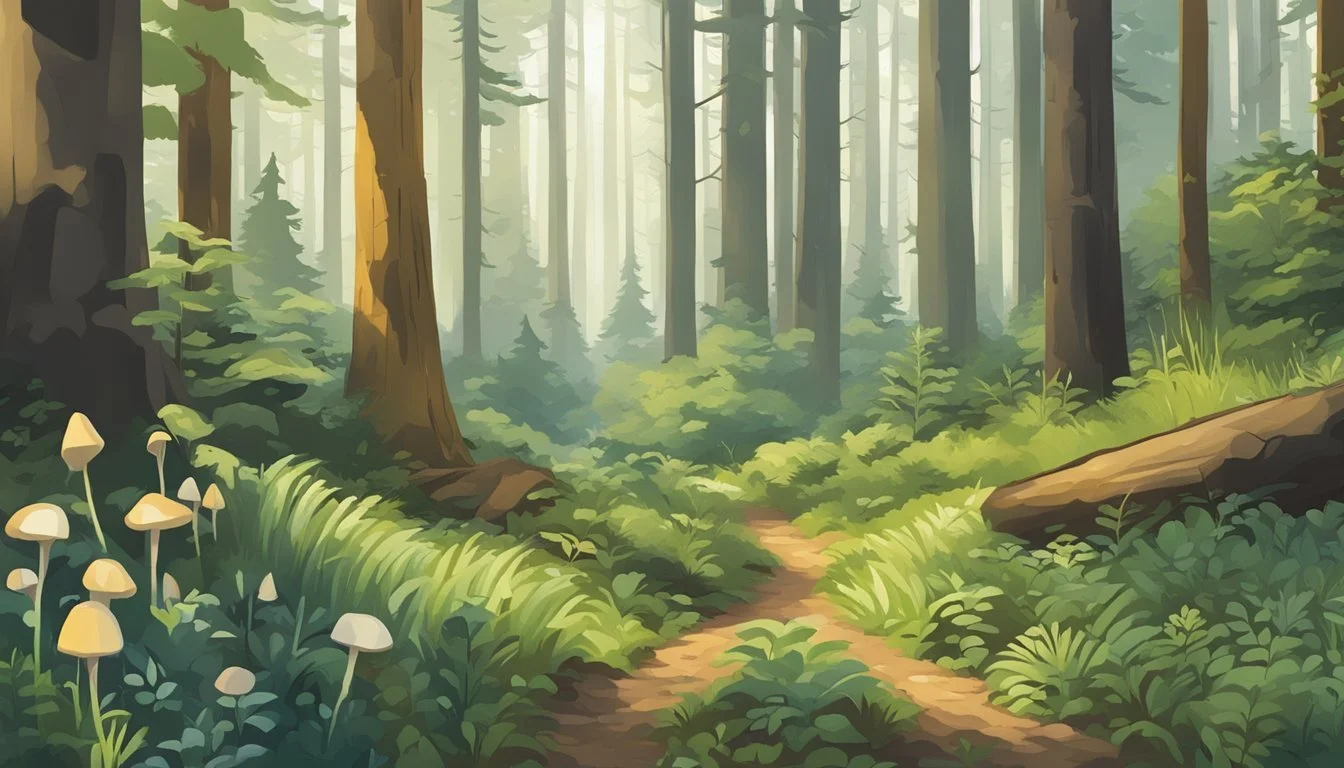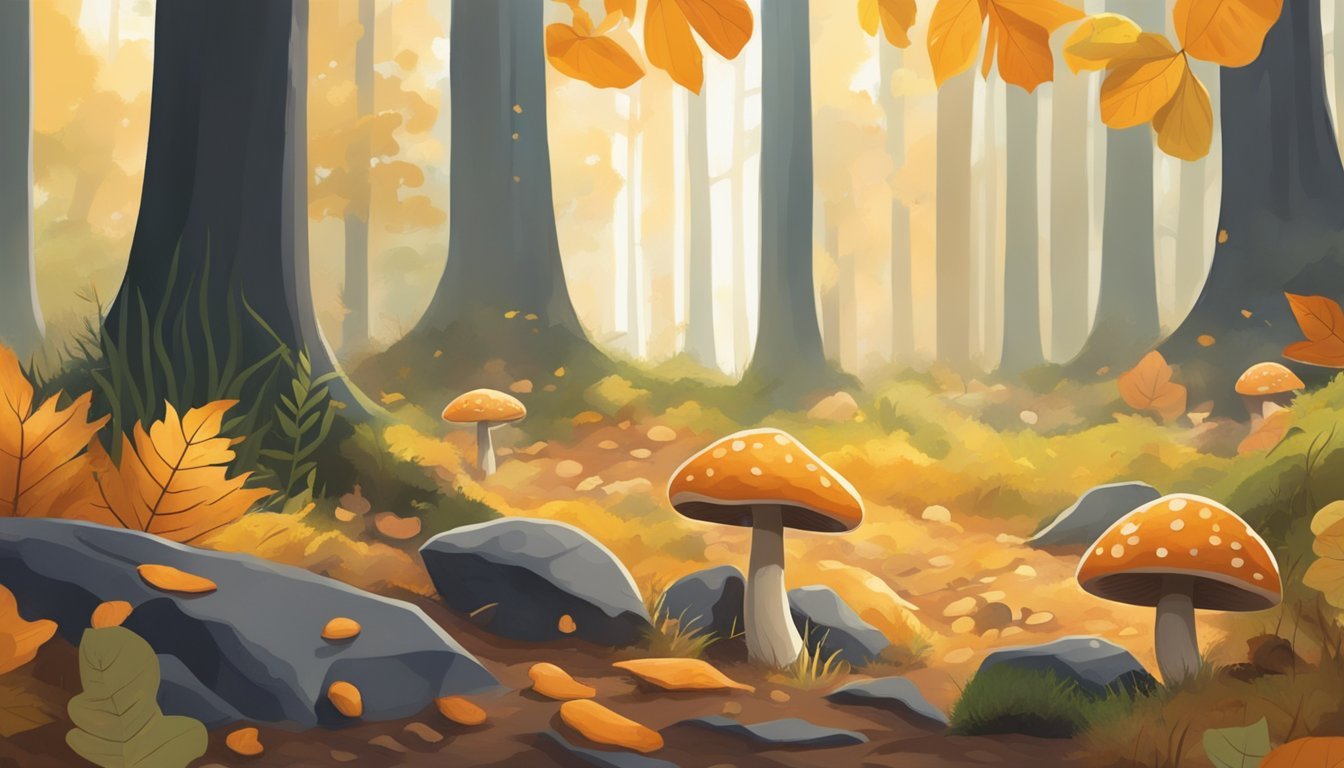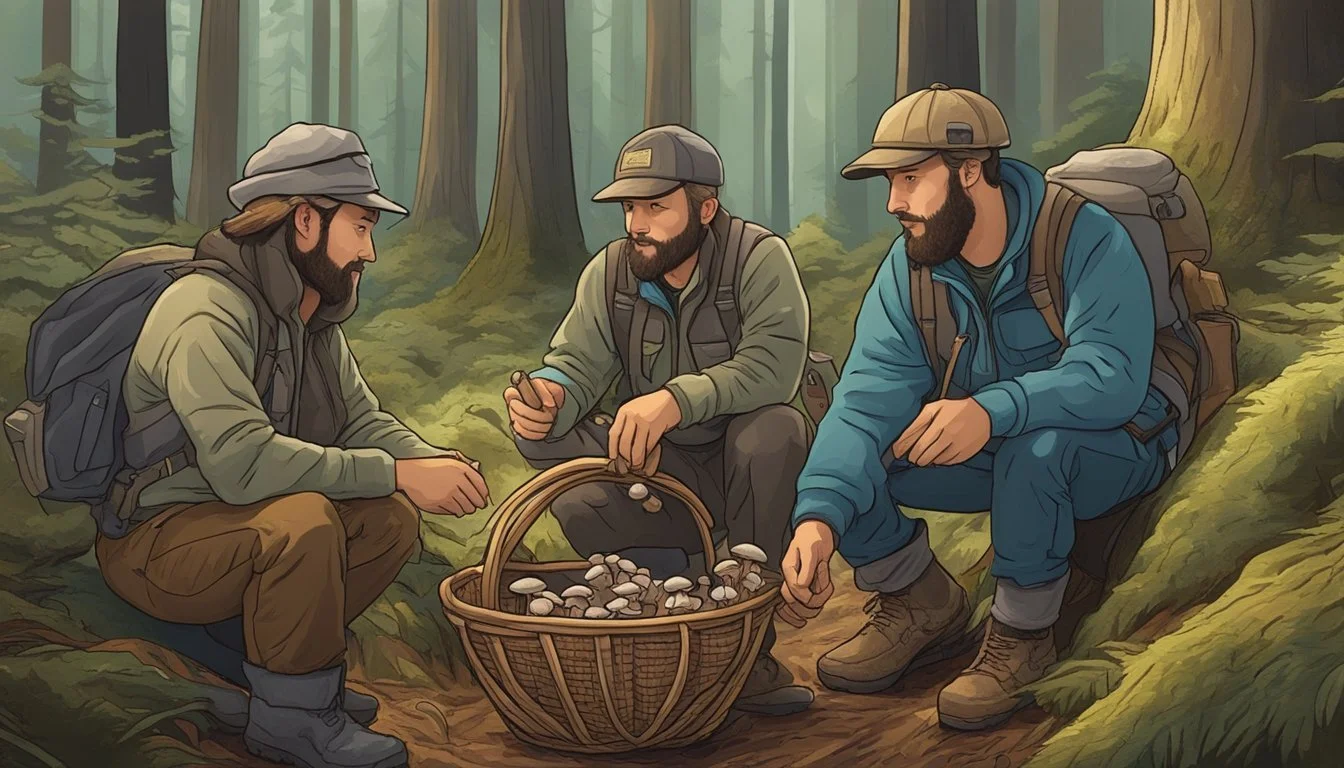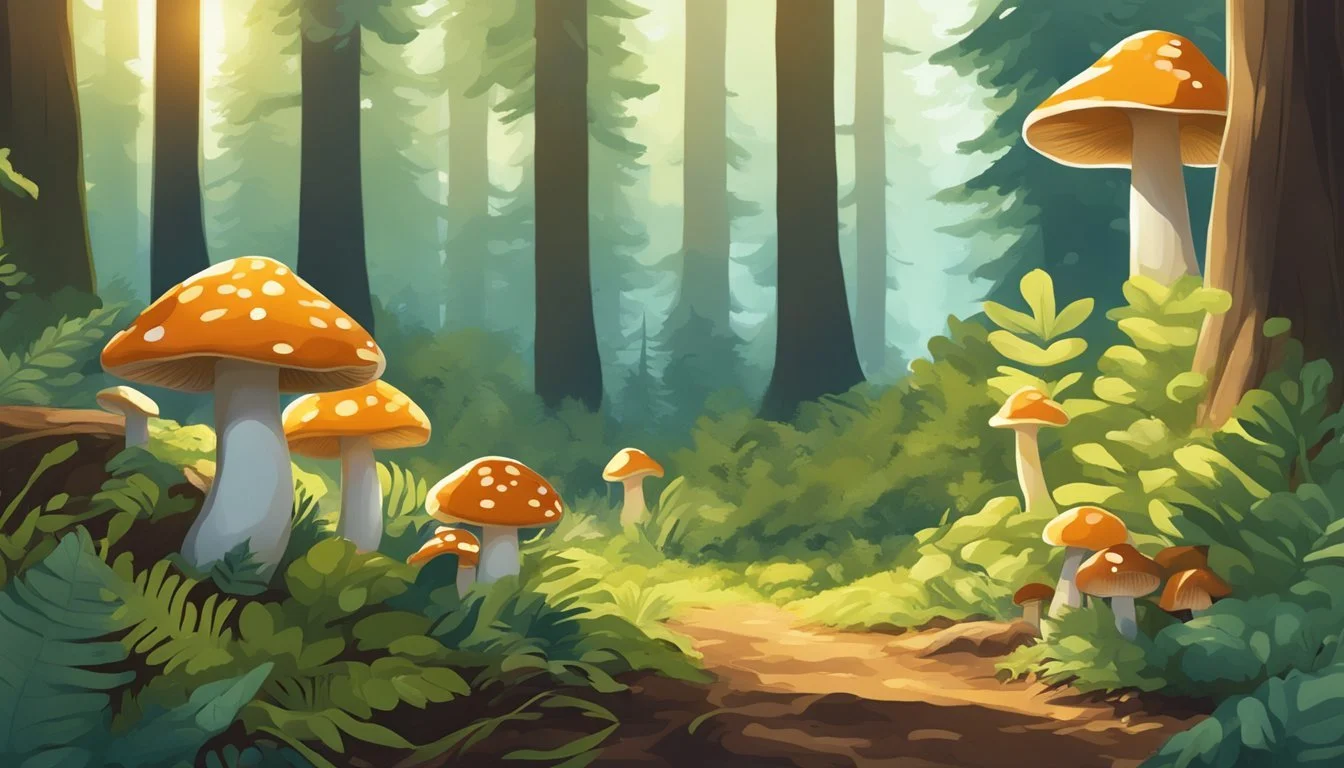Mushroom Hunting Oregon
A Guide to Prime Foraging Spots
This Article is Part of Our Guide on Mushroom Hunting for All 50 States
Mushroom hunting in Oregon is a pastime that combines the joys of exploration and the delights of culinary discovery. The region's diverse ecosystems, particularly the coastal forests, provide an ideal backdrop for this activity. With a climate that fosters a rich variety of fungi, Oregon is renowned for its abundance of edible mushroom species. Enthusiasts and foragers alike seek the prized chanterelles, elusive morels, and the esteemed matsutake among others.
The state's fall season is particularly significant for mushroom hunters as it marks the period when many edible species reach their fruiting peak. This typically begins in late August and can extend through November, with certain varieties occasionally found until December. The activity requires a keen understanding of the mushrooms (What wine goes well with mushrooms?) growth conditions, such as soil type, acidity, specific host trees, altitude, and the aspects of the surrounding environment.
Safety and respect for the environment are pivotal when mushroom hunting. Foragers must be able to accurately identify edible species, as some mushrooms can be toxic. Adherence to local regulations and obtaining the necessary permits, where required, ensure that the practice of mushroom hunting in Oregon is sustainable and retains its appeal as an environmentally-friendly pursuit.
Foraging for More Than Just Mushrooms in Oregon
Oregon's lush forests and diverse landscapes provide a wealth of wild edibles for the intrepid forager. While mushrooms may be the star attraction, the state's bountiful ecosystem offers an array of herbs, berries, nuts, and greens. From the misty coastal regions to the high desert, discover the delights of foraging in the Beaver State.
👉 Foraging for Wild Edibles in Oregon
Commonly Found Edible Mushrooms in Oregon
Oregon is home to several edible mushroom species. Some of the most commonly found edible mushrooms in the state include:
Morel Mushroom (Morchella spp): Highly prized for their unique, honeycomb appearance and earthy, nutty flavor, morel mushrooms are commonly found in Oregon's forests and are a favorite among foragers.
Chanterelle Mushroom (Cantharellus spp): Chanterelles are golden or yellow mushrooms with a delicate, fruity aroma and a mild, peppery taste. They are abundant in Oregon and highly valued for their culinary uses.
Lobster Mushroom (Hypomyces lactifluorum): The lobster (What wine goes well with lobster?) mushroom is a brightly colored, firm mushroom that has a seafood-like flavor and is often found in Oregon's forests, particularly under conifer trees.
Matsutake Mushroom (Tricholoma matsutake): Matsutake mushrooms have a spicy, cinnamon-like aroma and are highly valued in Japanese cuisine. They grow in association with pine trees in Oregon and are sought after by foragers.
Porcini Mushroom (Boletus edulis): Also known as boletus edulis, porcini mushrooms have a nutty, earthy flavor and are commonly found in Oregon's forests, particularly in moist, wooded areas.
Golden Chanterelles (Cantharellus formosus): Cap: Funnel-shaped with wavy edges, Gills: Presence of ridges instead of true gills, Habitat: Common in moist, coniferous forests.
King Boletes (Boletus edulis):Cap: Large, brown, and porous, Gills: Lacks gills; has a sponge-like layer of tubes, Habitat: Found near conifers and hardwoods: Found near conifers and hardwoods.
It is essential to properly identify any mushroom before consuming it, as some species can be poisonous. Beginners should go mushroom hunting with an experienced guide or join a local mycological society to learn how to identify edible mushrooms safely.
Basics of Mushroom Hunting
Successful mushroom hunting combines knowledge of seasonal growth patterns, appropriate gear, understanding of forest ecology, and adherence to safety and ethical guidelines. These fundamentals ensure a rewarding experience while respecting nature and promoting sustainability.
Understanding Mushroom Seasons
In Oregon, mushroom seasons are dictated by the specific species and the local climate. For instance, Pacific Golden Chanterelles are typically found in the fall, while Morels emerge in spring. A forager must be aware of these seasonal varieties:
Spring: Morels, Spring King Boletus
Fall: Pacific Golden Chanterelles, Matsutakes, Hedgehogs
Essential Equipment for Foraging
Foragers should equip themselves with the following items to enhance their mushroom hunting expeditions:
Knife: For clean cutting of mushrooms.
Basket or Mesh Bag: To carry and help spore dispersal.
Compass/GPS: For navigation within forests.
Field Guide: To identify mushrooms accurately.
Mushroom Habitat and Forest Ecology
Oregon's dense forests and consistent rains create ideal conditions for a myriad of mushrooms. Key habitats include:
Douglas Fir Forests: Often home to Chanterelles and Morels.
Mixed Hardwoods: May support diverse species like Matsutakes.
Understanding the symbiotic relationships between fungi and trees can increase a hunter's success rate.
Safety Guidelines and Ethical Foraging
Safety should be a forager's top priority. They should:
Identify: Confirm mushroom species to avoid poisonous varieties.
Inform: Tell someone about their foraging location and expected return time.
Ethical foraging includes:
Harvesting responsibly: Avoid over-picking in one area.
Respecting the habitat: Minimize impact on the forest ecology.
Mushroom Identification and Species
When hunting for mushrooms, it's essential to know the key characteristics that differentiate edible fungi from their toxic counterparts. Mushroom identification is critical as many edible mushrooms have poisonous look-alikes.
Morphology of Mushrooms
Mushrooms vary greatly in shape, color, and size, making morphology a vital aspect of identification. Key structural components include the cap, stem, and gills or ridges, each of which can vary among species. Spores, the reproductive cells of fungi, can also be vital for identification and are typically dispersed from the gills or ridges beneath the mushroom cap.
Poisonous Mushrooms to Avoid
It's crucial to be aware of poisonous mushrooms when foraging. Some species to be cautious of are:
Death Caps (Amanita phalloides)
Greenish or yellowish cap
White gills and stem
Destroying Angels (Amanita virosa)
Pure white cap, stem, and gills
Found in similar environments as edible species
Galerina marginata
Small brown cap and stem
Grows on dead wood; resembles some edible species
For safe foraging practices, one should only consume mushrooms that they are 100% confident in identifying. When in doubt, consult an expert or refrain from consumption.
Foraging Locations and Permissions
Mushroom hunting in Oregon offers a multitude of locations ranging from coastal forests to mountainous terrains, each subject to specific regulations and permit requirements to ensure sustainable harvesting and conservation.
Popular Mushroom Hunting Areas
Oregon's diverse ecosystems provide a variety of habitats that are perfect for mushroom foraging. Some of the most popular areas include:
Coastal Forests: These regions are abundant in mushroom species, with the Oregon Coast Range being particularly rich in fungal flora.
Cascade Mountains: Higher elevations, like those in the Cascade Mountains, yield a different array of mushrooms, especially after the snowmelt.
Willamette Valley: Surrounding the valley, the forested areas are also well-known for their mushroom abundance.
State Parks: Certain state parks in Oregon allow mushroom hunting, but it's critical to check park-specific rules before foraging.
Public Land Access and Regulations
When accessing public lands in Oregon for mushroom hunting, foragers must be aware of the regulations in place:
Permits: A mushroom permit may be required for harvesting, especially if individuals plan to collect large quantities or sell their finds. For example, the Willamette National Forest requires a $8 per day permit with a minimum of 3 days, or seasonal permits available at $200 or $100 for half the season.
Mushroom Caps Regulation: In specific forests like the Willamette National Forest, at least one-third of the mushroom caps must be left intact in the collection area to allow for spore dispersal and sustainability of the species.
Unlimited Quantities: Some areas may offer unlimited daily quantities for personal use, but commercial gatherers have different guidelines and limits.
It is imperative for foragers to consult with local park rangers or check online resources for the most current information regarding permits and regulations before venturing out for mushroom hunting. Compliance with these laws helps to protect Oregon's natural resources and ensures the continued enjoyment of foraging for future generations.
Timing and Climate Considerations
Mushroom hunting in Oregon requires understanding the interplay between the seasonal patterns and the climate to maximize success.
Season: The peak season for mushroom foraging typically falls between September and November, when the climate is more conducive to fungal growth. Although, different species may have varying fruiting times.
Fall: This period, characterized by cooler temperatures and increased rainfall, presents opportune conditions for mushrooms to thrive, especially in damp environments.
In Late Summer, specifically as August transitions into September, foragers might note a shift in mushroom variety as the climate begins to cool.
Spring is another season of interest, particularly after the first warm rains, which can stimulate mushroom growth.
Weather and Climate: Oregon's climate, which is generally wet and temperate within the forested regions, supports a broad diversity of fungi. Crucially, mushrooms prefer damp conditions, often flourishing after periods of rain.
Season Typical Climate Considerations Fall Cool and wet Optimal for many species Spring Variable, often wet After warm rains; look for morels Late Summer Transitioning, warmer Selection begins to change
Hunters should be aware that the weather, particularly out of season fluctuations, can disrupt the expected mushroom growth patterns. They should also consider the specific requirements of the targeted species, as growth conditions can vary widely, including necessary soil conditions and associated tree species.
Mushroom Hunting Groups and Societies
In Oregon, mushroom hunting groups and societies offer a rich tapestry of communal knowledge, events, and support. They cater to both novices and experts in the field of mycology and provide platforms for learning and sharing experiences.
Community Support and Learning Resources
Organizations like the Oregon Mycological Society (OMS) and the Cascade Mycological Society (CMS) serve as hubs for enthusiasts looking to dive into the world of mushrooms. They offer a variety of resources including:
Field Guides: Detailed books that help identify various species of mushrooms.
Guidebooks: Comprehensive materials that assist with hunting techniques and safety measures.
Facebook Groups: Online community spaces where individuals share their finds and advice.
These groups often maintain a calendar of events such as:
Workshops: Where members can learn about mushroom identification, harvesting, and cooking.
Meetings: Regular gatherings for discussions on mycology and related subjects.
Events and Festivals
Oregon celebrates the love for mycology through annual events and festivals, which are:
Mushroom Festivals: Annual events that celebrate the diverse fungal kingdom, such as the one hosted by the Cascade Mycological Society featuring talks, workshops, and forays.
These events provide excellent opportunities for mushroom enthusiasts to celebrate, learn, and engage with the mycological community. They serve as a perfect platform for networking and sharing experiences with fellow mushroom hunters.
Sustainable Practices and Conservation
Ethical Foraging: It is essential for mushroom hunters in Oregon to practice ethical foraging. This means being selective, taking only what one needs, and leaving enough behind to allow for natural regeneration. A good rule of thumb is to forage less than one-third of the visible mushrooms in a given area to ensure sustainability.
Leave-no-trace: This principle involves minimizing the impact on the natural environment by sticking to established trails and avoiding trampling sensitive undergrowth.
Spore dispersal: Cut or lightly twist the mushrooms from the ground to allow spores to remain in the area, which supports future growth.
Conservation Efforts: Mushroom hunting should align with conservation efforts to protect wildlife and their habitats. It involves being mindful of the local ecosystem and recognizing the role mushrooms play in the forest's life cycle.
Species Protection: Hunters must ascertain that they are not harvesting rare or endangered species, adhering to conservation laws and regulations.
Naturalist Approach: They should adopt a naturalist's perspective, appreciating the interconnectedness of fungi, wildlife, and the broader ecosystem.
Identification: Proper identification of mushrooms is paramount to avoid disturbing non-edible or toxic species inadvertently.
Education: Seeking knowledge from experts and local mycological societies can enhance one's understanding of regional fungi and their habitats.
Sustainability: The overarching goal is to ensure that mushroom hunting activities do not impair the forest's ability to naturally sustain its fungi populations for future generations. Engaging in practices that promote ecological balance will help maintain Oregon's rich biodiversity.
Preparing and Cooking Wild Mushrooms
Proper handling is crucial to ensure that wild mushrooms are both safe and enjoyable to eat. The process involves meticulous cleaning and storage, followed by cooking that is tailored to the unique characteristics of each species.
Cleaning and Storage
When handling wild mushrooms, one should clear away dirt and debris without causing damage. Cleaning typically involves gently brushing the caps and stems with a soft brush or damp cloth. Storage requires careful attention to prevent spoilage:
Edible mushrooms should be kept cool and dry.
Store mushrooms in paper bags or waxed paper, never in plastic which can cause sweating and spoilage.
Use stored mushrooms within a few days to ensure freshness and prevent the development of harmful bacteria.
Culinary Uses of Different Species
Each mushroom species brings its own unique flavor and texture to recipes, with varying culinary applications:
Morels: Rich, nutty flavor suited for sauces and as a complement to meats.
Chanterelles: Delicate and slightly peppery, ideal for sautéing or creamy dishes.
Lobster Mushrooms: Firm texture and seafood-like taste, excellent in stews.
Health-wise, mushrooms add valuable nutrients to a diet with minimal calories. They can prove to be a substantial part of a healthy diet. When incorporating wild mushrooms into recipes, it is important to note their compatibility with other ingredients and the preferred method of cooking to bring out their best qualities. Always cook wild mushrooms thoroughly to break down any potential toxins and to render them more digestible.
Advanced Topics in Mycology
In advancing mycological studies, particularly in Oregon, one must consider the complex nature of mycelium and the innovative techniques in fungiculture, as well as the utilization of scientific research and identification tools that aid in the meticulous work of mycologists.
Mycelium and Fungiculture
Mycelium, the vegetative part of a fungus, consists of a network of fine white filaments (hyphae) that plays a critical role in nutrient absorption and the breakdown of organic materials. Fungiculture has evolved significantly; it's the art and science of cultivating fungi in controlled environments for various purposes, including gourmet food production and ecological conservation. Fungi for the People, an Oregon-based initiative, is at the forefront in this realm, providing workshops and resources for those interested in integrating fungiculture into sustainability practices.
Practical Steps in Fungiculture:
Selection: Choosing appropriate fungal species for cultivation based on environmental conditions and desired outcomes.
Substrate Preparation: Assembling nutrient-rich mediums such as sawdust or grain for the mycelium to colonize.
Inoculation: Introducing fungal spores or cultures to the substrate in a sterile environment to initiate growth.
Incubation: Maintaining optimal conditions for mycelial expansion and development.
Fruiting: Triggering the mushroom-producing phase under controlled humidity, airflow, and temperature conditions.
Scientific Research and Mushroom Identification Tools
Mushroom identification requires precision, as many edible species have toxic look-alikes. Scientific research in mycology often involves taxonomy, genetics, and the biochemistry of fungal species. The Pacific Northwest Mushroom Identification Forum is an essential resource for mycologists and hobbyists alike to exchange knowledge on mushroom identification. They emphasize the importance of reliable identification tools, such as field guides, DNA sequencing, and collaboration with seasoned experts, to ensure accurate and safe identification of wild mushrooms.
Key Identification Tools:
Morphological Analysis: Examining the physical characteristics of mushrooms, such as cap shape, color, and spore prints.
Chemical Testing: Using substances like KOH or Melzer's reagent to test for chemical reactions that help in identification.
Molecular Techniques: Utilizing advanced DNA analysis to confirm species when macroscopic identification is challenging.
Community Engagement: Participating in forums and workshops that provide hands-on experience and knowledge sharing with seasoned mycologists.
Local and Online Resources
When hunting for mushrooms in Oregon, it's essential to have reliable resources for identification and best practices. Whether you're a seasoned forager or new to the hobby, the right tools and information can enhance your experience.
Mushroom Identification Apps and Forums
Various apps and online forums are invaluable for foragers seeking to identify mushrooms. One can opt for mushroom identification apps that use photos to help determine species. For a communal approach, forums such as the Pacific Northwest Mushroom Identification Forum offer a platform where foragers can share insights and seek advice from experienced mushroom hunters. Additionally, Facebook groups dedicated to local foraging can be useful places to ask questions and learn from others' experiences.
Oregon-Based Foraging Publications
The Oregon Mycological Society provides comprehensive materials and field guides for those interested in mushroom foraging. They offer a range of publications detailing the fungi native to Oregon, which are crucial for both safety and conservation. Additionally, specific guidebooks tailored to the region, available at local bookstores or through the society, serve as excellent resources. These guidebooks often contain detailed information on mushroom species, including photographs, descriptions, and habitat notes, which are essential for accurate identification.
Conclusion
Mushroom hunting in Oregon encapsulates the essence of Pacific Northwest exploration. The activity is not only enjoyable but provides enthusiasts with a deeper understanding of the region's diverse ecology. Admirers of nature can immerse themselves in the lush coastal forests that offer a rich array of edible fungi. Beginners should focus on easily identifiable species such as the Golden Chanterelle and the Delicious Milky Cap, while more experienced foragers may seek the elusive Matsutake or Lobster mushrooms.
Those who participate must approach the environment with respect, ensuring that they only pick what they need and can identify with certainty as safe to consume. Foragers are always reminded to adhere to local regulations and to forage sustainably to maintain the delicate balance of the forest ecosystem.
The health benefits of sustainably foraged mushrooms, coupled with the rewarding experience of discovering them, make mushroom hunting a compelling activity for many individuals. It encourages physical activity, mindfulness, and provides an opportunity to savor nutritious additions to one's diet.
Benefits of Mushroom Hunting in Oregon Connects people with nature Offers nutritional benefits Supports sustainable practices Encourages learning and discovery Fosters a sense of community
In summary, Oregon's habitat is conducive to mushroom hunting, and this endeavor continues to be an enriching pastime that supports well-being and ecological appreciation. Enthusiasts cherish this connection with nature, often sharing their knowledge and experiences, thus reinforcing the community's growth and passion for this timeless pursuit.








